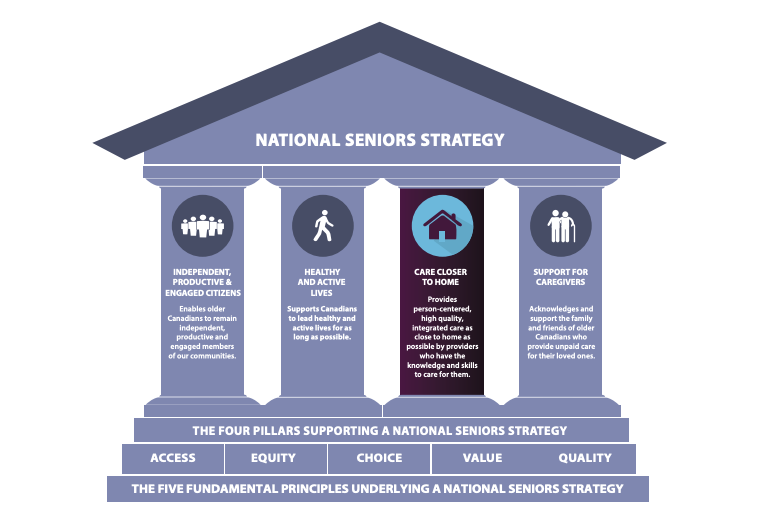On September 10, 2019 the National Institute on Ageing (NIA) based out of Ryerson University in Toronto, Ontario released an important report entitled Enabling the Future Provision of Long – Term Care in Canada.[1] The report authored by Dr. Samir Sinha, who has also been a panelist at previous BC Care Provider Association (BCCPA) Conferences[2] explores the current landscape of the full range of long-term care services across Canada to determine how Canadians can be best supported to age with greater quality of life, better health outcomes, as well as dignity through appropriate models of care and support and best practices.[3]
The NIA report also goes on to outline the foundation for more a responsive Long-Term Care System in Canada by identifying four enablers for future change including: 1) the development of integrated person-centered systems of long-term care; 2) system sustainability through improved financial arrangements, strong workforce and enabling technologies; 3) more standardized health assessments; and 4) policy approaches.
 Overall, the NIA report also highlights some of the critical challenges that seniors face including around receiving timely access and quality of care particularly with a rapidly aging population. For example, as noted in the report over 430,000 adult Canadians were recently estimated to have unmet home care needs while over 40,000 Canadians are currently on waitlists for nursing homes due, in part, to a lack of available home and community-based care.[4]
Overall, the NIA report also highlights some of the critical challenges that seniors face including around receiving timely access and quality of care particularly with a rapidly aging population. For example, as noted in the report over 430,000 adult Canadians were recently estimated to have unmet home care needs while over 40,000 Canadians are currently on waitlists for nursing homes due, in part, to a lack of available home and community-based care.[4]
Similar challenges around access to care were also highlighted in the 2019 BCCPA report entitled Bedlam in BC’s Continuing Care Sector, which focused largely on meeting the anticipated demand for new long term care beds in British Columbia.[5]
The author of the Bedlam report, Michael Kary (BCCPA Director of Policy and Research), who was also one of the reviewers of the latest NIA report highlights that “the latest NIA report, provides a lot of good information on many of the challenges providers face as we attempt to look at innovative models and solutions to provide better access and quality care to seniors as well as deal with a rapidly aging population”. Kary also notes that “I look forward to the other papers as NIA attempts to assist government policy and decision makers, existing care providers and members of the general public to clearly understand the options available to meet the long-term care needs for Canada’s ageing population”.
The latest report is the first in a three-part NIA Policy Series on the Future of Long-Term Care. The second report will show projected future costs of home, community, and nursing home care, while the final installment of the series will bring together the NIA’s expertise in financial and health policy with the aim of presenting feasible and fiscally responsible policy scenarios that have the potential to improve quality of life for seniors in care and the value of services delivered.[6]
END NOTES
[1] National Institute on Ageing. (2019). Enabling the Future Provision of Long-Term Care in Canada. Toronto, ON: National Institute on Ageing White Paper. Accessed at: https://static1.squarespace.com/static/5c2fa7b03917eed9b5a436d8/t/5d767f2fcb287b468e8c40f9/1568046896685/Future+of+Long-term+care_V7_final+-+09-09-2019.pdf
[2] BCCPA. Care to Chat to Focus on Health Human Resource Issues in Continuing Care. March 2016. Accessed at: https://bccare.ca/2016/03/care-chat-focus-health-human-resource-issues-continuing-care/
[3] As noted in the NIA report there is no single definition for long term care. The report, however, defines long term care as a range of preventive and responsive care and supports, primarily for older adults, that may include assistance with Activities of Daily Living (ADLs) and Instrumental Activities of Daily Living (IADLs) provided by either not-for-profit and for-profit providers or unpaid caregivers in settings that are not location specific and thus include designated buildings or in home and community-based settings.
[4] Gilmour, H. (2018a). Formal home care use in Canada. Statistics Canada, Health Reports, 29(9), 3-9. Retrieved from: https://www150.statcan.gc.ca/ n1/pub/82-003-x/2018009/article/00001-eng.pdf
[5] BCCPA. Bedlam in BC’s Continuing Care Sector: Projecting Future Long Term Care Bed Needs. May 2019. Accessed at: https://bccare.ca/wp-content/uploads/2019/05/Bedlam_in_BC_Continuing_Care_Sector.pdf
[6] National Institute on Aging. Canada is Not Keeping Pace with the Home and Community, and Nursing Home Care Needs of its Rapidly Ageing Population. September 10, 2019. Accessed at: https://static1.squarespace.com/static/5c2fa7b03917eed9b5a436d8/t/5d77ac0f6e88e408ffa37bc3/1568123920143/%5BPRESS+RELEASE%5D+Canada+is+Not+Keeping+Pace+with+the+Home+and+Community%2C+and+Nursing+Home+Care+Needs+of+its+Rapidly+Ageing+Population.pdf




